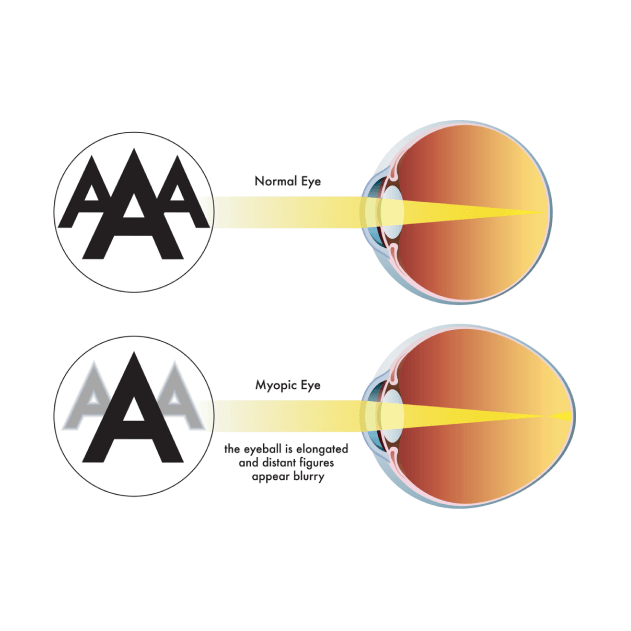
What is Myopia?
Myopia, also known as nearsightedness, is a prevalent eye condition that affects many people worldwide (expected to increase to 50% of the world’s population by 2050). It is characterised by a clear vision for nearby objects while distant objects appear blurry. Individuals with myopia can typically read books or view objects up close without difficulty, but they face challenges when it comes to seeing objects that are farther away.
In some cases, individuals with undiagnosed myopia may experience headaches and eyestrain as a result of the constant effort required to focus on distant objects. It is important for individuals experiencing these symptoms to seek an eye examination to determine if myopia is the underlying cause.
Myopia, or nearsightedness, occurs when the eye grows too long from front to back, resulting in a refractive error. The main causes of myopia are:
Eye shape: In individuals with myopia, the eyeball tends to be longer than normal from the front to the back. This elongation of the eye causes the light entering the eye to focus in front of the retina instead of directly on it. This contrasts with the condition of hyperopia or farsightedness where light entering the eye focuses behind the retina.
Corneal curvature: Another factor contributing to myopia is a cornea that is excessively curved or steep, such as a condition called keratoconus or conical cornea. The curvature of the cornea affects how light is refracted and focused on the retina.
Lens thickness: The thickness of the lens in the eye can also contribute to myopia. If the lens is thicker than normal, it can cause light to focus in front of the retina.
While there may be a genetic predisposition to myopia, environmental factors (lack of outdoor sunlight exposure) and visual habits also play a role. Individuals who engage in prolonged near-work activities, such as reading, use of smartphones/ iPads/ tablets, computer use, or intense close-up tasks, may have a higher likelihood of developing myopia. However, the exact interplay between genetics, environment, and visual habits in the development of myopia is complex and still not fully understood.
Untreated myopia can have negative effects on quality of life, causing limitations in activities and ongoing eye strain with associated headaches. There is also an increased risk of complications such as retinal detachment, glaucoma, cataracts, and myopic maculopathy which is a form of macular degeneration unrelated to old age. Regular eye examinations and appropriate correction or myopia treatment are important to mitigate these risks and improve eye health.
Symptoms of myopia, or nearsightedness, often first manifests during childhood and tend to progress as they grow into adulthood. The following are common symptoms associated with myopia:
Blurred Vision: Objects in the distance appear blurry, while close-up objects remain clear.
Distorted Vision: Distant objects may appear distorted or elongated.
Squinting: To improve focus, individuals with myopia may squint (“screw up” or narrow their eyelid opening) their eyes, attempting to bring distant objects into clearer view.
Eye Strain and Headaches: Straining the eyes to see clearly can lead to eye fatigue and tension, resulting in headaches.
It's important to note that experiencing these symptoms does not definitively indicate myopia, as they can also be related to other vision conditions. A comprehensive eye examination by an eye care professional is necessary to determine the presence and extent of myopia.
What is Progressive Childhood Myopia?
Progressive Childhood Myopia refers to the continuous worsening of nearsightedness that begins in early childhood and continues to steadily increase as the child grows. This can result in:
High myopia: Nearsightedness where the eye requires a correction of -6.0 dioptres or more. It increases the risk of retinal tears, retinal detachment, cataracts, and glaucoma, each of which can lead to vision loss.
Pathological myopia: Nearsightedness where the eye requires a correction of – 8.00 dioptres or more. This can cause degenerative changes in the retina, choroid, vitreous, sclera, and optic nerve, with the most serious being myopic maculopathy that may result in legal blindness (< 6/60 or unable to see the top letter of a vision chart).
Progressive Myopia is caused by the eye growing too quickly compared to the normal rate of eye growth. The exact cause of this rapid growth is unknown, but studies suggest increased near-work activities (such as reading and use of electronic devices) and decreased outdoor sunlight exposure have impacted the prevalence of Progressive Myopia.

The aim of Progressive Myopia treatment is not just to correct vision, but also to slow down the rate of myopic progression.
The first step is to make an appointment with an eye care professional if you notice any symptoms of myopia. Early detection and treatment will help minimise the risk of myopic progression.
Limiting the duration of near based activities to less than 20-30 minutes at a time and aiming for approximately 2 hours of physical activity in outdoor daylight per day, are easy and effective lifestyle changes that can help naturally reduce myopic progression.
If a child has more than 1 dioptre of myopia by the age of 5, additional treatment options should be considered, these include:
Glasses with specialised lens designs
These lenses use specialised technology that incorporates multiple segments with different refractive powers into different zones of the lens. The central area of the lens corrects the child’s distance vision, while the peripheral segments create myopic defocus. The peripheral defocus helps to regulate the growth of the eye and slow down the progression of myopia.
Soft contact lenses with specialised designs
These follow a similar optical principle to that of glasses with specialised lens designs.
Gas-permeable hard contact lenses
Also known as Orthokeratology, these contact lenses are worn at night while you sleep and are removed during the day. The lenses apply gentle pressure on the cornea, temporarily altering its shape. This controlled change in corneal shape is thought to create an optical aberration that creates the necessary myopic defocus in the peripheral retina.
Eye Drops
How the use of low-dose atropine drops works in slowing down myopia progression is uncertain. The theory is that it somehow slows down the growth of the eye by a direct action on the retina and perhaps the sclera (outer white coat of the eyeball). Drops are used once a day in the evening.
